Technology disruption is proliferating at a pace faster than most anticipated. Most organizations are going through a phase of urgency and an imperative to transform. This blog provides an overview of the challenges with the transformation and introduces a framework for Enterprise digital transformation and a detailed guide to achieve digital transformation dexterity.
A must read for the CTO/CIO/Transformation Leaders
Download the whitepaper here: DigitalTransformation
Executive summary, The Imperative
“Only thing that is constant is Change! “ – Heraclitus
World is changing at an accelerated celerity, use of technology and its adoption is shaping our lives in unprecedented ways.
To be successful in this ever changing technology landscape as an enterprise is to digitally assimilate.
Technology advancements has enabled new capabilities such as 3D printing, Biochips, Connected* (everything), Internet Of Things, Machine Learning, Wearables, Cloud, etc. fostering creativity and endowing neoteric business models.
While there are enterprises who are leaders in innovation and the very reason for the above, there are others who realize this change and want to get there at the earliest. The obvious other side of this coin is being in a position of sustenance or being obsolete.
Investing in this change (digital) is imperative to stay relevant. The once famous brands such as Tower Records, Circuit City, and Borders, to name a few are now defunct for NOT investing in digital/innovating at the right time.
Technology has greatly influenced human behavior and continues to do so, few above mentioned technologies and a lot more of them will completely change the world we currently live in. Enterprises will need to transform themselves and achieve the digital transformation dexterity to emerge as leaders, some will accomplish this sooner, and some will play catch, inevitably every organization has to be part of this CHANGE.
Walking down the memory lane
“Technology has advanced more in the last thirty years than in the previous two thousand”, – Neils bohr.
The technology advancements in the last couple of decades have extensively impacted our lives, prevalent practices are becoming extinct, adding new dimensions to behavioral science and social sciences. Paper invented around 105 A.D is battling its way across many industries, digital has replaced it as the de facto standard for content creation

Travel has evolved from months to days to minutes across the world, Education has evolved from books to tabs, writing from quills to digital pens, health care has evolved from dreadful diseases to proactive monitoring sensors to 3D printed stem cells, manufacturing has evolved from labor to robots, Museums from ancient artifacts to digitized animations, Finance from cash to cards, from physical transfers to touch and go, Food from farmers to super markets to made on the internet grocery stores, entertainment from plays to 4 dimensional cinemas, theaters to streaming devices from meeting in person to dating online. Every physical object, activity, experience is getting a digital makeover at accelerated pace.
Since the creation of web in 1989, the search engines have become the information access gateway, changing the way data is collected, stored, retrieved and utilized. Organizations align themselves to be ranked highest in the search engines, a critical business success factor. Now, Social media portals has extended the gateway and are competing strongly with search engines to be the primary information gateway.
The last decade influenced the adoption of Web, Virtualization, Cloud, Social and mobility. This decade while building on the above will influence the adoption of smart *(Devices, Wearables, Cities, Home, robots, Advisors etc.), Connected home, Internet Of Things, M2M. The number of devices predicted to reach 20 to 200 billion will shape newer protocols for messaging and communication and with data volumes in zetta bytes big data, NoSQL and analytics will continue to receive complete cynosure. Data insight from customers/consumers, machines will be better understood and the service industry will strive for better experiences which will include predictive analysis, machine learning, data science content analytics and more. Automation revolution will eventuate across industries.
From a sales and marketing perspective, Products available solely in stores, gradually made its way to door ways. While some adopted intrusive knock on the door tactics, some chose to be less intrusive with banners, demonstration platforms etc. Concepts emerging from waiting for customers to reaching out to customers, searching for products in stores to making the products readily available where customers are, from generalized, to personalized, from waiting for customers, to search for what they need, to making customers feel that the product is a necessity.
Has the strategic decisions that the management needed to make, change from a decade ago? Yes. Risks are much higher. The pace and magnitude of potential business disruption is much higher. The need for agility is greater. The need for transformation is thus greater.
Defining Enterprise digital transformation
Is digital transformation same as customer experience, business transformation, IT transformation, modernization of systems, cloud adoption, Infrastructure refresh, incorporating innovation stream, revamping skills?
Customer experience: I have seen some material online which focuses on one of the above mentioned areas and thus defines transformation to be so. I believe that every business thrives for a better customer experience, technology and tools which gets us closer to the customer be it mobile devices or Wearables or devices such as Eddy stones or ibeacons, NFC’s or RFID’s will eventually enable us to have better insights of customer and thus help serve them better. Adopting one of these technologies will help enrich customer experience, but with the pace of changing landscape, the question is if that will sustain long term? The challenge is, constant evolution and if the enterprise is set up to evolve.
Business Transformation: The epicenter of Enterprise digital transformation is business transformation, however, it cannot be the only one. For an enterprise to be successful all the functions will have to align and support this change.
IT transformation, modernization of systems, cloud adoption, Infrastructure refresh, incorporating innovation stream, revamping skills: As mentioned earlier, Enterprise digital transformation is an all-encompassing change.
Enterprise digital transformation can be defined as “the comprehensive collaborative changes an enterprise undergoes to evolve and align itself to the changing digital landscape, a paradigm shift in thinking universally impacting the organizational design, strategy, people, service, process, governance, technology, tools and systems resulting in newer revenue models, better performance, faster time to market and sustained strategic growth”
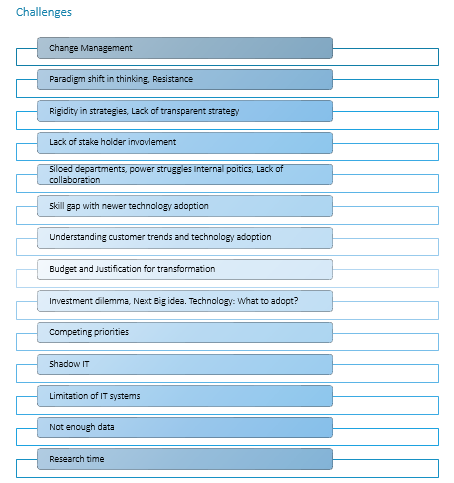
Change Management
Dr. Henry Cloud stated that “We change our behavior when the pain of staying the same becomes greater than the pain of changing”, there is also a saying that “We can change culture if we change behavior”.
The problem with transformation is that there isn’t an end state, and the target end state is determined through trial and error, learning/emerging process. People used to legacy methodologies and project management with time bound project plan find this very uncomfortable. Also being comfortable with legacy practices, the teams feel that the new changes is radically different from what they have been doing and they cannot reason why that change is needed.
Change management is addressed by many companies in the means of top down dictated change. This creates lot of friction and resistance. Culture being one of the most important part of the organization, leaders need to make sure that the changes aren’t dictated but rather evangelized, sometimes with new people, mind sets, attitudes and behaviors. Also too many initiatives within a short period of time without proper prioritization can cause additional resistance. Transparency is key, along with greater collaboration with teams, and a well-rounded representation of people in the change leadership. Engaging employees in the planning and envisioning stages, getting their inputs will lead to a successful transformation
Paradigm shift in thinking, Resistance
Change in business thinking? Change in processes? Changes in technical implementations? Resistance is seldom due to technical reasons. Resistance is the most when egos are hurt, when there is a behavioral change needed, when there are mandates, when opinions aren’t heard, mindset towards change, perceptions, belief/disbelief in leadership, the change initiatives, and the change evangelist.
Rigidity in strategies
When the end state is evolving, there need to be agility in adopting strategies as well. Open communication and collaboration helps garner trust from the teams and helps embrace the transformation. Some companies start creating the roadmap/strategy keeping key industry trends at that point in time, however the technology landscape is fast emerging, so the roadmap should not incorporate too much rigidity and should be flexible and should be refreshed as needed.
Lack of stake holder involvement
If a transformation is not championed by the enterprise leaders and is further not endorsed by the stakeholders, then “Failure is pretty much guaranteed”. Transformation by the nature of it impacts every aspect of the organization and warrants support from each and every stakeholder.
Siloed departments, power struggles, internal politics
Some transformation efforts are started by certain departments. Some are driven top down. Some leaders create separate departments and run them like a separate organization with startup mindset and principles. When there are many silos within the organization the communication and collaboration becomes too difficult. Some silos are more open to the idea than the others. If the leaders choose a particular department to champion the transformation, other leaders might not be fully cooperative. Some leaders also choose a particular department to show success, other leaders who compete might perceive or portray this as a failure. Certain organizations are siloed in a way as to share the responsibilities. The start of execution might begin with a department, associated with a hand over to other and to the other and so on. In such organizations a failure usually results in blame game. Some departments might lack the sense of ownership. There also might be lack of tools, technologies which helps track progress across organizations. Some departments might also feel that this transformation might not result in any benefit to their department and is a waste of time.
Skill gap with newer technology adoption
The idea of skill gap is disputed/argued many a times. The gap in adoption of newer technology, strategic thinking in my view are undoubtedly true. Companies either need to wait till the technologies mature enough before adoption or invest in developing the skill required themselves. Even with technologies which have been around for over a decade such as cloud computing (note the concept is probably much older), companies still struggle to implement.
Understanding customer trends and technology adoption
Google glass, fitbits, smart watches, Cooey, jawbone, Kindle, drone, hoverboards, Roku, NaviBot, Smart * (* mirror, fridge, TV, City, energy meter, glass, kitchen, watch), facebook, whatsapp, Hololens, snapchat, twitter, Instagram, 3Doodler, Oculus, NFC, android, Cloud POS, Beacons, QR Codes, EMV, magnetic stripe cards, Google Wallet, Apple Pay, CurrentC, mobile payments, connected home, Bugatti Veyron, Ducati, Tesla, Hybrid cars, ! What is the next big trend? Some trends are very hard to predict, a risk taking company comes up with a product and blow customers of their feet and suddenly everybody wants the product. While some products have so much hype, but fails to impress. Sometimes it is just timing and sometimes marketing.
Budget and Justification for transformation
There are multiple business models, technologies, strategies and often with them comes competing priorities. Leaders often find it difficult to balance between keeping the lights on to new initiatives, a proven idea might be relatively easier to be funded, than a journey towards achieving the same.
Investment dilemma, Next Big idea. Technology: What to adopt?
Cloud Computing- public, private, hybrid, NOSQL – CAP Theorems, Key value, document, tuple, graph, object, column, Containerization, Virtualization, Big Data, Data Lakes, Predictive Analytics, Machine Learning, data mining, adaptive, fraud detection, data science, regression, sentiment analysis, Augmented reality, Bio chips, IOT, Connected home, Autonomous Vehicles, 3DPrinting, Wearables each of these areas offers a multitude of further options with each vendor differentiating themselves in many ways.
Gartner hype cycles to Forrester waves, quadrants to radars, there are quite a few industry research that help company’s guide technology adoption.
When there are multiple leaders formulating the transformation ideation process the ideas collide and make it difficult to make a choice.
Competing priorities
Deloitte survey identified competing priorities as the top barrier from digital transformation adoption. Stakeholder value, customer value, employee value, core business value, extended related values, innovation, internal alignment, external alignment, stakeholder commitment, business roadmap, technology roadmap, overarching EA roadmap all of these need to be measured and factored in to short term and long term goals.
70-20-10, Technology push, market pull, phase gate model, are some of the models that are adopted for innovation management.
Managing priority is not the same as innovation management, maintaining current applications, to balancing initiatives usually is quite dependent on the leaders and their influencing authority. In siloed organizations, certain departments take more precedence than the others.
Organizations find it extremely challenging to manage these priorities and implement an overarching transformation.
Shadow IT
While IT department drives some organizations, Marketing drives a few and so on. The important fact about the above statements is that the strategy is silo driven. When one department feels that IT is not keeping up with the pace the business wants to move faster, they will find means to get their ideas implemented in other ways. Result is Shadow IT. Sometimes even with in IT there are multiple shadows. One department say, Bi with in IT wants to show/help influence that they are early adopters of technology so they go ahead and implement cloud or Big data. While being a risk taker or experimenting is very important, so is being transparent. But, unfortunately, teams choose not be transparent because of the restrictions/constraints imposed on them. In many instances a certain not so well thought through initiatives fail, some initiatives might fail because of the constraints posed by other departments or leaders.
The negative impact of such experiments failure goes much deeper. When there are transformation initiatives, and technology drivers have been tested by a few and have failed due to whatever reasons, there is skepticism in adoption and less collaboration.
Limitation of IT systems
IT systems and its capability to support the business growth is extremely critical. Non performant applications, applications with architectural/design limitations, short staffed IT teams, investments in systems that do not scale, etc have caused grief to business leaders. Change in business direction seeks for IT agility, faster time to market. IT with system limitation severely constraints the business growth. Organizations will need to find ways to alter the IT DNA, recover investments, and achieve the elasticity and agility in growth.
Not enough data
Quite a few leaders although keen on implementing new industry trends, technologies or embarking on the digital transformation journey find it difficult to pursue the same because of insufficient data. Leaders who initiate and evangelize are often asked for data points to prove that the idea works. Sometimes the challenge is not so much as to whether a technology works, rather how that can be applied to the organization.
Research time
Certain organizations spend too much time to determine the end state of the transformation, be it to gather data points for a business case, direction to adopt etc. When there are lot of such initiatives and not enough success factors associated with them, the business find it challenging to invest in further research time. Sometimes even a great idea will get shut down without enough time invested in it. Newer technologies need time to be adopted.
Enterprise Tenets
There is a saying “A smooth sea never made a skillful sailor”. Big is the challenge, so is the opportunity.
Below diagram shows the tenets of an enterprise which will evolve in the course of the transformation

Organization divestitures, acquisitions, mergers, and the associated attributes to the above diagram such as values, behaviors, mindsets, perceptions, goals, performance, philosophy, core beliefs, history, current skills, legal constraints, risk preparedness of the leadership, motivation, trade unions, legacy, and more attributes to the overall decision making process.
Enterprise digital transformation framework
In order to transform, first we need to understand a few things:
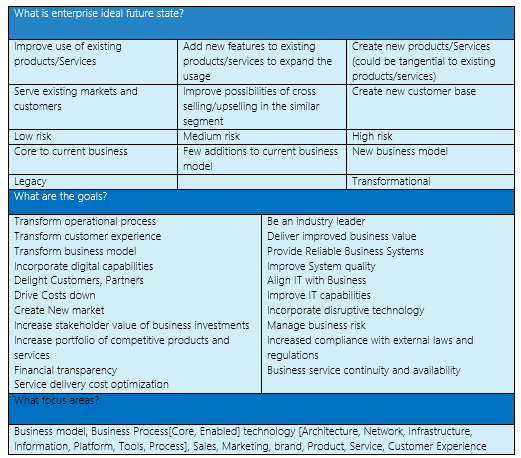
The Enterprise Digital Transformation framework has been developed to help envision ambitious goals, assess accurately the current state of the organization, create a realistic roadmap, target state and successfully implement an enterprise digital transformation.
Framework:
Steps to implement transformation
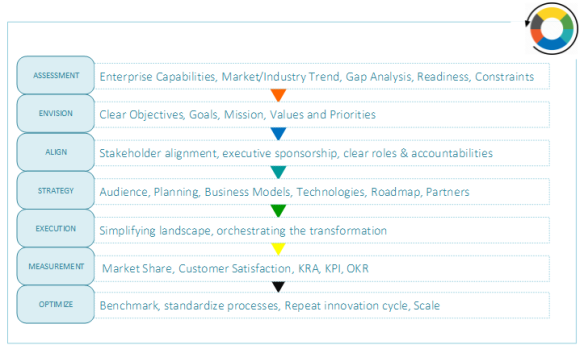
Assessment
Before embarking on a transformation journey, it is important to analyze the organization situation and the need of the hour. What areas of the organization are impacted? As noted in the previous section, all the tenets of the enterprise will be impacted and depending on the focus of the transformation one more than the other.
Our framework segregates the assessment in to 2 main categories.
- External assessment
- Internal assessment
External
Market or Industry trend analysis, Technology trend analysis, and competitor analysis are some of the flavors of external assessment. This is key to understand where the enterprise wants to be in the transformation roadmap.
The below diagram shows few methods to perform the analysis that the framework uses:
Note: In depth information of the methods out of scope for this blog.
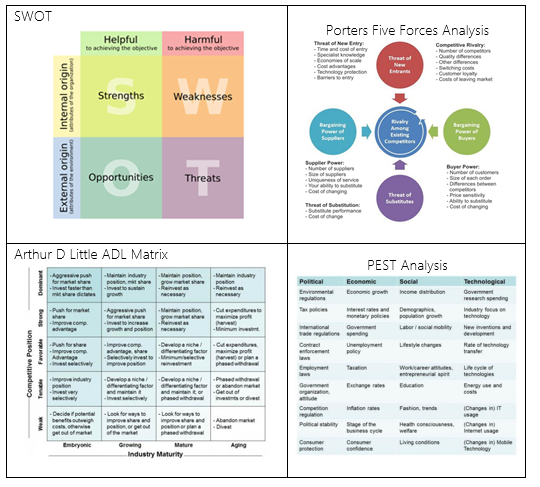
Reference:
- https://en.wikipedia.org/wiki/SWOT_analysis
- https://en.wikipedia.org/wiki/Porter_five_forces_analysis
- http://www.comindwork.com/weekly/2015-08-03/productivity/five-forces-analysis-porter
- http://www.strategyhub.net/2010/01/framework-of-week-31-adl-matrix.html
- https://en.wikipedia.org/wiki/PEST_analysis
The above assessment provides valuable information on the competitors direction, there are further assessments which help where the enterprise determine their competitive position in the organizations value chain
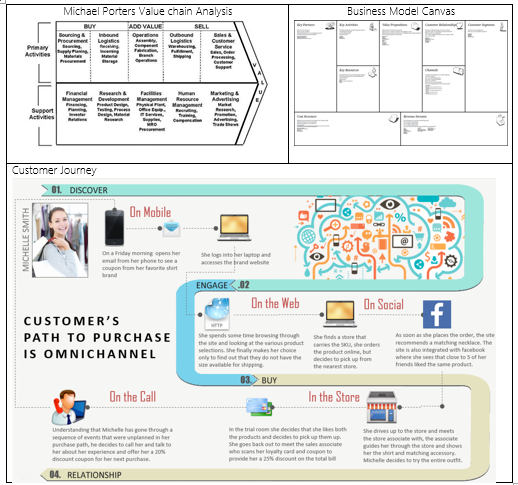
Reference:
- http://ssaps.co.uk/strategic-issues/enhanced-value-chain/
- http://www.businessmodelgeneration.com/canvas/bmc
Technology direction and its alignment to strategy plays a significant role in the transformation
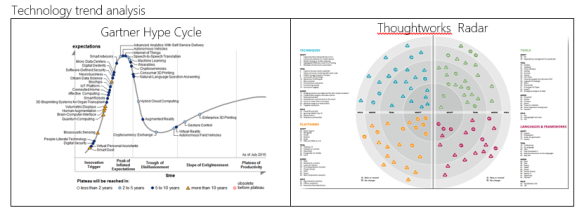
Internal
Internal assessment is performed to understand how to achieve the transformation. Assessments such as Organization assessment, Enterprise Architecture Assessment, Digital Capabilities assessment , Skill Assessment , Gap Assessment , Readiness Assessment
Marvin Weisbord Six-Box Model, Open Systems Model, Causal Model of Organizational Performance & Change(Burke & Litwin Model), The Seven-S Model, Organizational Intelligence Model, Universalia Institutional and Organizational Assessment Model (IOA Model) are some of the organization assessment frameworks.
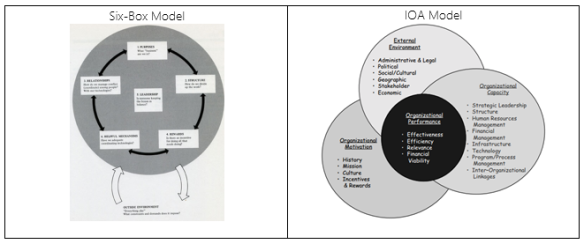
Reference:
- http://www.marvinweisbord.com/index.php/six-box-model/
- http://reflectlearn.org/discover/universalia-institutional-and-organizational-assessment-model-ioa-model
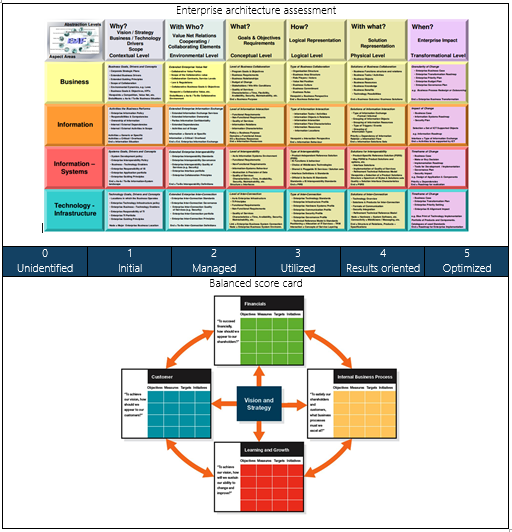
Reference:
- http://www.zachman.com/about-the-zachman-framework
- http://blog.bizzdesign.com/business-performance-management-balanced-scorecards-and-the-decision-model
EA assessment captures all the architectural dimensions, the following diagram captures the IT assessment categories in the framework
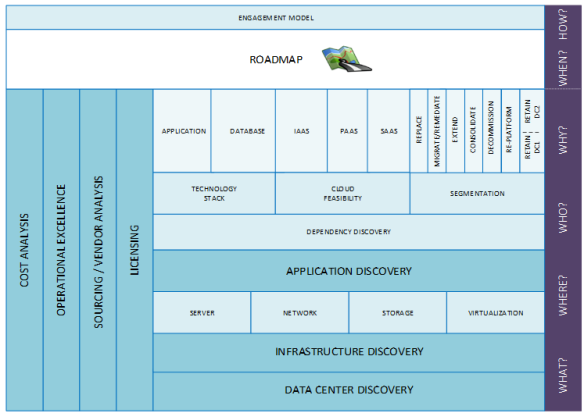
With a comprehensive assessment and understanding of competitor standings, external and internal impediments, technology and business direction along with a clear gap analysis, the leaders will have the data to comprehend the extent of change impact and form a clear transformation strategy. This data enables the leaders champion the strategy with internal and external stakeholders, in order to do so the leaders need to share their vision.
Envision – goal
Envisioning the target state of the enterprise and setting clear objectives to achieve the same is extremely important. Google uses OKR process to set objectives and measure them. The key is to be ambitious. The goal should clearly articulate the organization motivation, reflect on the history and mission of the organization and will be aspirational to the employees while helping in garnering the support from the teams and the stakeholders.
Align – leadership, get executive sponsorship
The next and the most important step in the process is aligning all stakeholders. While a complete strategy and a plan is not needed at this point of time, stake holders will surely be keen to see them. The leaders should ensure that this is not mandated by the stake holders, else this can potentially get to a chicken and egg situation. The assessment should provide clear data points to convey the strategic imperatives and the drivers for the transformation. Effective leaders can use this phase to clearly identify roles and accountabilities within the leadership team. Certain organizations might need to restructure themselves, shut down certain units, or transfer units, or partner with other organizations or create subsidiary units to augment the current teams. Most organizations benefit from agile ways of working, and large enterprises will have to significantly alter their processes. This requires complete alignment, executive sponsorship, 100% support from all the leaders involved.
Strategy
Significantly drifting business and technology drivers, customer sentiments and adoption, organizations ability to anticipate and take agile actions depends heavily on the strategic direction of the enterprise. Getting it right, and sustaining the direction is the ONLY way to success. `
- Clearly understand the general direction of the transformation journey, realize that there will be changes
- Discuss the digital mandate openly and transparently. Share the vision and evangelize the ideas. Appreciate participation, Involve teams, get inputs
- Enable rapid decision making
- Metamorphose the organization in to an agile, flexible vehicle
- Create a platform for faster, scalable and elastic delivery
- If an idea has to fail, fail fast, learn fast and succeed fast
- Empower innovation, align with strategy
- Manage innovation – Google mandates 10% to transformational innovation, balances keeping the lights on with new initiatives
- Build a innovation incubator, leverage partnerships to be elastic
- Identify candidates to demonstrate success, target low hanging fruits, quick wins
- Govern, measure, optimize, repeat
There are multiple levers for Innovation management strategy, some choose to create separate departments, while some choose partners to pilot innovation, some adopt radical approaches such as completely separate company, and some choose to integrate innovation with the business by creating an innovation team in conjunction with business. If the transformation goal is to stay within the general business domain, then this approach makes the most sense, however, there is no right or wrong approach and it really depends on the kind of organization and its strategic focus.
With the data obtained from the assessment and the alignment from the leaders, the “what” is needed should be clear. Based on that data, the strategy of “How” is determined.
Strategy creation process can incorporate the following, business strategy view, value chain view, business capabilities view, value stream view, organizational view, business case, business model, engagement model, resourcing strategy, process rationalization, enterprise architecture roadmap, architecture refresh, application rationalization, IT infrastructure optimization/consolidation, target operating model creation, governance structure, etc.
Cost Analysis
People cost, cost for transforming business processes, device cost, facility cost, energy cost, business cost (production, manufacturing, raw materials, etc.), IT cost (Optimizing operations, infrastructure, server hardware, operating system, License, network hardware, virtualization cost, storage cost, data center floor space cost, power cooling cost, cloud cost, partner cost, health care cost, learning and development cost, research cost, vacation pay cost, wages, salaries, corporate events and parties, travel lodging, severance, restructuring, bonus, capex, opex etc. Understanding the ROI of investment and making the right adjustments, focusing investment are fundamental to a strategic roadmap. A clear path to fund the transformation
Changing business models, uncertainty, and ideation are all part of the tilting landscape, traditional processes and development methodologies are too rigid, the need of the hour is faster time to market, cross functional teams, the incremental delivery, and a general attitude and paradigm shift towards adopting newer leaner methodologies.
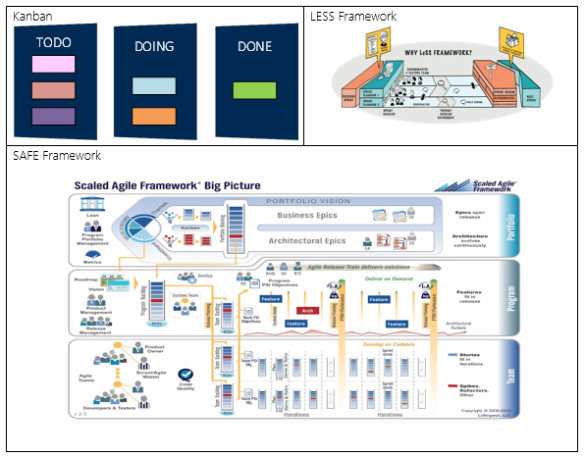
Reference:
Target operating model: Where needed, changing the organization structure and determining a target operating model, Vision and mission, Segregating core and non-core functions, Governance structure, organization design, identifying the right people skills and the mode of their work, Processes, and determining optimal technology, tools and systems form the components of the target operating model. This also includes identifying partnerships needed, sourcing strategy and change management
Target Operating Model Components
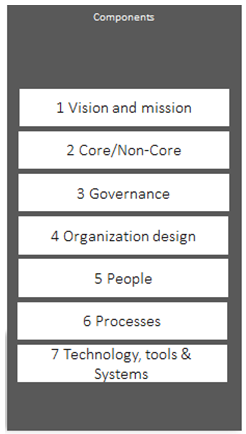
Target Operating Model defined with the associated development methodology, Organization design, aligned processes etc.
Execution
Stage where all the action happens. Well thought through strategy, great attention to detail, astute change management tactics, simplified landscape, agility in execution, a collaborative, can do temperament, slowly working through the constraints, a clear transition planning will lead to a successful execution of orchestrating the transformation.
Morris Chang stated “Without strategy execution is aimless, without execution strategy is useless”.
Transformation execution not only defines the leader and his capability but also the organization character, determination, and conviction to excel and transcend competition
Measurement
Constant measurement helps alignment to strategic objectives, justification of transformation and improvisation. Understand how well the enterprise is performing, where improvements are needed, if goals are met, if customers/partners are satisfied via Margins, Growth, Market share, Market penetration, Business value, customer satisfaction, complaints, retention, Net promoter score, ROI, ROCE, Productivity, effectiveness, efficiency, quality, timeliness, accuracy of service, response time, delivery time, accessibility, integration, collaboration, speed to market, and more.
Determine the overall maturity of the organization

Reference:
A balanced score card has a good balance of measures and objectives and is a great tool for strategic performance management
Optimize
Execution is complete with measurement, feedback, improvisation and optimization in a continuous loop. Standardize the methodologies implemented, create benchmarks and scale what works while discontinuing what doesn’t and adapting accordingly.
Conclusion
No two organizations are the same, likewise no two transformations will be the same. What worked for others might not work for you, however being cognizant of options, helps you make better decisions, learn from others mistakes, while making a few yourselves. When change is imperative, DO nothing IS NOT an option, if you don’t, your competitors will. Legacy organizational units have been around for too long, too reactive to influence change. As enterprise are emerging we also see different roles emerging such as CMO, CDO, etc. which are transformation centric. The strategies employed by the stakeholders are to enable change catalysts. Transformations aren’t going to be easy or short, failure isn’t either. Transform your way to success!
